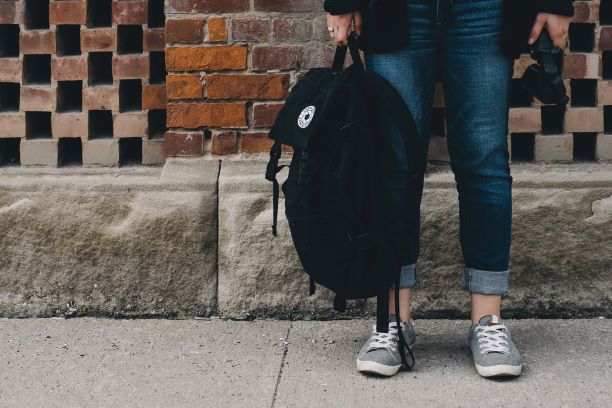Human trafficking is everywhere, including schools. The very idea seems unimaginable. And yet, whether a school is in an urban, suburban, or rural community, students may be at risk of human trafficking and exploitation. Any minor who is recruited for the purpose of commercial sex is a victim of human trafficking. Federal law does not require force, fraud, or coercion.
Have you wondered what puts a student at-risk? How a student can become a victim? Do you want to know what schools are doing and what students themselves can do?
In our Back to School series, we will take a closer look into the intersection of human trafficking and schools. Join us as we understand what the risk factors are, what parents can do, what schools are doing and can do to protect students, and what students can do to bring awareness and protect their peers. This post will explore the vulnerabilities that put students at-risk and what parents can do.
What it looks like and how it happens
Everyday, there are children and youth who are at-risk of being exploited or who may in fact be exploited while attending school. Victims can be any age, race, gender or nationality, including U.S. citizens. Students can be at risk of sex trafficking, labor trafficking, or even both simultaneously. Victims can also be college and university students.
While there is no one face of a human trafficking victim, runaway and homeless youth are especially vulnerable to trafficking. Youth who are facing challenging or unstable family situations can be at risk as well. One of the top 5 risk factors for human trafficking in 2018 was being a runaway or homeless youth, according the National Human Trafficking Hotline statistics. Due to their lack of a supportive network, runaway youth are often approached by traffickers with the promise of food, shelter, protection, or a better life.
In addition to homelessness, youth who are currently or were previously in foster care, gangs, and the juvenile justice system are also vulnerable to human trafficking.
However, youth who are performing well in school, involved in sports and extracurricular activities, and have strong parental support can be vulnerable as well. Affluent communities, private schools, and met needs do not exempt a student from being vulnerable.
So how does a student become at-risk? They often seek connection, affirmation, popularity, and acceptance in the friend groups they engage with, the social media they post and share, and the events they attend. Students’ access to the Internet, social media, texting, vlogging, etc. are all intersections where traffickers can monitor and engage with them. At the mall, the movies, or parties, traffickers can approach a youth or send a peer to establish trust and ultimately recruit them. Students attending parties is another way they can be lured by traffickers.
Students who are eager to fit in and appear “cool” or “popular” may be recruited by an older student on campus. At the party, they may be drugged, recorded, and then threatened, being told that the video will be shared with everyone if they don’t do as they are told.
Or a student may have an older boyfriend/girlfriend who invites them to a party and then asks for a favor, telling them that they owe someone, but if they perform this sexual act, the debt will be paid.
Students may also be offered a job while in high school or college. Traffickers posing as talent agencies, modeling agencies, or businesses looking for new employees may present themselves to students on campus.
Traffickers pressure, manipulate, and intimidate youth, asserting control and instilling fear. Traffickers will lie to students, threaten to harm their families, and blackmail them (sextortion).
In 2018, over 18 million reports were made to the National Center for Missing and Exploited Children CyberTipline, including reports related to “online enticement, including ‘sextortion’” and “child sex trafficking.”
While any student can be at-risk, fellow students, parents, and school staff can make a difference.
As a parent, what can I do?
It’s often hard for parents to imagine their youth may be at-risk. But it’s important to know that anyone can be at risk, and even if your child is not, they may have friends who are.
Some indicators parents can look for include:
- Missed school without parent permission
- An older boyfriend/girlfriend
- Unexplained cash, expensive clothing, purses, makeup, etc.
- Sudden academic decline
- Change in friendships and relationships with peers or teammates
Parents can
- Educate students, including children and teens, about Internet safety
- Monitor social media accounts
- Stay up to date with academic and extracurricular activities
- Know who their students hang out with
- Equip them so they will know how to reach out for help if they need it
While parents can learn indicators, red flags, and warning signs, many students may not self-identify as a victim. They may not come forward because of shame, distrust, a trauma bond with their trafficker, or fear of threats made against family or friends. Learn how to keep your student safe and talk to them.
Knowing the risk factors and warning signs, Internet safety (parents and children), and reporting suspicious activity to the National Hotline, NCMEC CyberTipline, and your local authorities is crucial.
Every child deserves to feel and be safe. Help the students in your life and community by knowing what to look for, equipping them, and reporting.
Now that you have learned about how youth are vulnerable, take the next step: earn your free Human Trafficking Awareness Badge with Justice U™.

